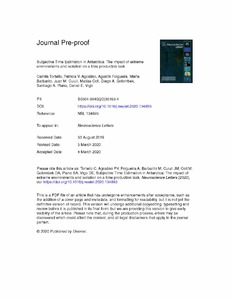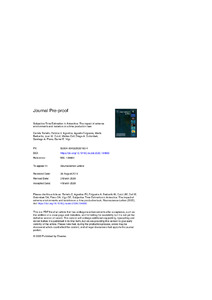Por favor, use este identificador para citar o enlazar este ítem:
https://repositorio.uca.edu.ar/handle/123456789/10065| Título: | Subjective time estimation in Antarctica : the impact of extreme environments and isolation on a time production task | Autor: | Tortello, Camila Agostino, Patricia V. Folgueira, Agustín Barbarito, Marta Cuiuli, Juan Manuel Coll, Matías Golombek, Diego A. Plano, Santiago Andrés Vigo, Daniel Eduardo |
Palabras clave: | ANTARTIDA; RITMO CIRCADIANO; AISLAMIENTO; TIEMPO; PERCEPCION; REGIMENES DE LUZ | Fecha de publicación: | 2020 | Editorial: | Elsevier | Cita: | Tortello, C., et al. Subjective time estimation in Antarctica : the impact of extreme environments and isolation on a time production task [en línea]. Postprint de artículo publicado en Neuroscience Letters. 2020, 725. doi:10.1016/j.neulet.2020.134893. Disponible en: https://repositorio.uca.edu.ar/handle/123456789/10065 | Proyecto: | Cronobiología del aislamiento antártico: la utilización de la Base Belgrano II como modelo de desincronización biológica y análogo espacial | Resumen: | Abstract: Time estimation is a major cognitive ability that allows humans and other animals to optimize behavioral functions. These activities require the skill to measure the elapsed time in several intervals [12], and involve multiple cognitive processes like attention, memory and decision making [47]. To assess this phenomenon, the most used procedure is interval timing [20, 25, 29, 43] which studies how a time interval is perceived, represented and estimated in a range of seconds to minutes [12]. Several studies have centered their attention on variables that can modulate time perception, such as emotion-related arousal [18, 49] and attention [46]. Other time scales of biological timing, like circadian or seasonal cycles, have also been proposed to influence interval timing [3, 21, 24]. Indeed, recent research have demonstrated the effects of the circadian clock on short-time estimation [1, 13]. Both the circadian oscillator and the sleep homeostat [11] appear to influence the rate at which the pacemaker emits pulses, evidenced in overproductions [48] . The accuracy of timing performances can also be influenced by environmental variables [22]. In this respect, the extreme photoperiod of Antarctica, with up to four months of complete darkness (polar night) is an ideal experimental setting to determine the impact of different zeitgebers on circadian human rhythms. Influences of mood state and fatigue on time production task have also been reported [23]. Both variables, together with negative affect and hostility, constitute some of the prevalent psychological symptoms during polar expeditions [8, 38]. The impact of this context on cognitive processes is variable, with reports of no changes [19, 55], increases [9] or decreases in performance [39, 42]. Thus, circadian rhythms and emotional processes have a key relevance in the cognitive functions involved in time estimation. These factors are affected by extreme photoperiodicity, isolation and confinement conditions found in Antarctica. However, there is no evidence about how time estimation unfolds in this context. Therefore, the aim of this study was to assess interval timing in a crew overwintering in Antarctica. Our hypothesis is that polar night and isolation affect the cognitive processes required to estimate time during an overwintering mission in Antarctica. Accordingly, we expect to find less accurate performances and longer intervals due to the lack of natural light exposure and to emotional variations associated with prolonged isolation and confinement. | URI: | https://repositorio.uca.edu.ar/handle/123456789/10065 | ISSN: | 0304-3940 (online) | Disciplina: | MEDICINA | DOI: | 10.1016/j.neulet.2020.134893 | Derechos: | Acceso abierto. 12 meses de embargo | Fuente: | Neuroscience Letters. 2020, 725 |
| Aparece en las colecciones: | Artículos |
Ficheros en este ítem:
| Fichero | Descripción | Tamaño | Formato | |
|---|---|---|---|---|
| subjective-time-estimation-antarctica.jpg | 319,76 kB | JPEG |  Visualizar/Abrir | |
| subjective-time-estimation-antarctica.pdf | 1,72 MB | Adobe PDF |  Visualizar/Abrir |
Visualizaciones de página(s)
219
comprobado en 27-abr-2024
Descarga(s)
330
comprobado en 27-abr-2024
Google ScholarTM
Ver en Google Scholar
Altmetric
Altmetric
Este ítem está sujeto a una Licencia Creative Commons

